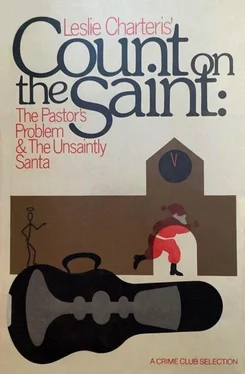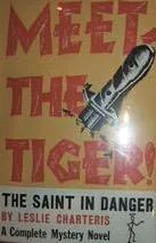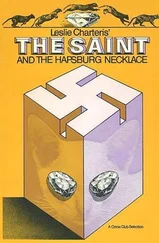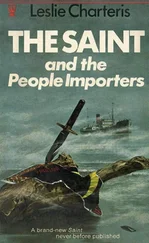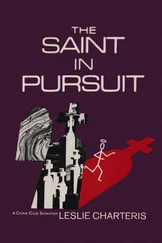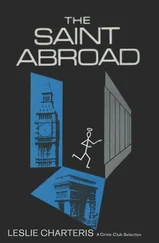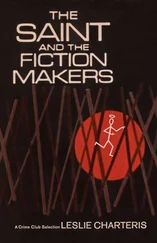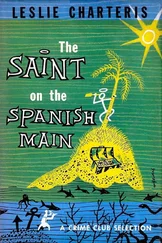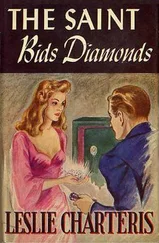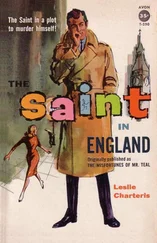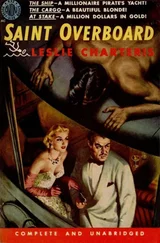“Then Taffy gets away with it,” said Father Bernardo. “It doesn’t seem right.”
“It’s not,” Simon admitted. “But that kid hasn’t got the brains to stay out of trouble for long, and next time he won’t be so lucky. At least you won’t be seeing him around here any more.”
“You know, I really thought he had changed,” said Father Bernardo. “I thought that I — we had changed him.”
“Like the man said, you can’t win ’em all,” said the Saint. “What is important is that you don’t stop trying.”
“You are right of course,” Father Bernardo said. And then he smiled. “But then, as a priest, how could I disagree with a Saint?”
II
The Unsaintly Santa [2] Original outline by Donne Avenell Developed by Graham Weaver
There is an art to the making of mulled ale. The beef should be strong and dark but not too bitter. A steady hand should add the cloves, and the nutmeg should be little more than a suggestion. The brew should be warmed beside the fire, not heated over it. Finally it should be decanted into a pewter tankard and savoured at leisure.
The ale Simon Templar was drinking was a perfect example of that art. The Crown may be the most common pub name in England, but the inn displaying that sign in a cobbled lane under the shadow of St. Enoch’s College, Cambridge, was no run-of-the-barrel beerhouse.
In summer it was almost impossible to make a path to the door through the throng of tourists. But now, with only a few days left before Christmas, the visitors were long gone and the university students who comprised the hard core of regular patrons were on vacation. Simon’s only companions were a couple of ancient worthies playing dominoes, the landlord polishing glasses behind the counter, and his overfed Alsatian lying in front of the fire. The Crown offered a choice of two bars, one small and the other tiny. Simon sat in the larger saloon, but even this measured only some twenty feet square. The ceiling was low and bowed between the rough oak beams supporting it. Pewter and brass glowed in the mellow light of oil lamps and candles. High-backed wooden settles, polished by the posteriors of countless generations of drinkers, warded off the draughts, and the blaze in the inglenook looked hungry enough to devour half a tree at one sitting. Above the mantel, poker-burned into a thick elm plank, was an exhortation to customers:
A pint in the morning to welcome the light,
A score or more between then and night.
Go to bed sober, dream without sin,
Get up in the morning and attack it agin.
Simon Templar reserved his doubts about the recommended quantity but raised his tankard to the sentiments of a simpler age.
Those whose knowledge of his life style was founded on their reading of the popular press might have been surprised to find him in such surroundings. Somehow the Crown did not fit the image of the high-living man about town which the gossip columnists projected. Nor did it reflect the picture painted by that other breed of journalist with whom he most frequently came into contact — the crime reporters. The first would not have appreciated the fact that a roaring fire, a drink, and the company of a landlord who is also a friend can be luxury enough. And as for the crime writers, they would immediately have concluded that only some illegal enterprise could have brought the Saint to Cambridge in winter. And, not for the first time in their careers of chronicling Simon Templar’s actions, they would have been totally wrong. Unless, of course, there is legislation to prevent bookmakers being parted from their profits.
It had been an undramatically successful day that had begun with the impulse to leave the smog of London for an afternoon’s racing at Huntingdon. It had continued with three wins in the first four races before the snow had come and caused the rest of the meeting to be abandoned. The blizzard had been so fierce that he had opted for covering the sixteen miles to Cambridge rather than the sixty six back to town.
The storm had blown itself out by the time he had registered at one of the better hotels in the city, but the snow still lay deep and crisp and even, and the walk from the University Arms Hotel to the Crown had chilled him enough to make the mulled ale a particularly welcome form of central heating. After an hour’s reminiscing with the landlord he sat beside the fire considering how to spend the remainder of the evening.
As clairvoyance was not one of the Saint’s gifts, he could not know that the Angel of Adventure who so frequently and welcomingly intervened in his affairs had already made the decision for him.
The grandfather clock in the corner chimed seven, and his thoughts turned to the subject of dinner and a small restaurant off King’s Parade where memory told him the food and wine would reach the standard he required. He drained his tankard and stood up. With a promise to the landlord to return the next day before starting for home, he left the inn.
The wind was still cold and sharp and he paused after a couple of paces to pull up the collar of his sheepskin coat. One glance at the sky said there would be more snow before morning. The distant voices of carol singers drifted from the direction of St. Enoch’s as he turned his back on the comforting lights of the Crown.
The lane was little more than an alley separating the confines of the college from the main thoroughfare which lay on the other side of the buildings backing onto the pub and its adjoining terrace of small shops and cottages. One hundred yards from the Crown it opened into a secluded square dominated by the tall turreted gateway of St. Enoch’s.
It was a couple of years since he had last visited Cambridge, but he recalled the layout of the city well enough. The college buildings ran parallel to the river Cam with King’s Parade lying on the other side of the grounds diagonally across from the square he stood in. To follow the roads round would entail a journey of more than a mile, but by cutting through the precincts the distance was nearly halved.
The gateway comprised a wide arch spanning the drive which led from the square, with two narrower tunnel-like entrances on either side for pedestrians. Heavy iron gates barred the central and right-hand openings so that visitors were channelled past the gatekeeper’s rooms in the left-hand tower. Ignoring a notice stating that only those with business at the college would be admitted, the Saint strolled through and entered St. Enoch’s.
The College of St. Enoch’s, Cambridge, had instructed its first pupils a century before the Armada. It had been established by the rich local wool merchants eager to buy their way into the aristocracy on earth and the heaven hereafter by donating some of their gold to good works.
The elegant halls they had paid for had graced the banks of the Cam for four hundred years until progress, in the shape of nineteenth-century taste, overtook them. To the Victorian industrialists who became the college’s patrons it was not enough for the seat of learning they were supporting to be old; it also had to look old. Consequently they had torn down and rebuilt or simply covered up and enlarged. The mullioned windows, the gables, and the mellow brick had disappeared beneath an avalanche of mortared flint and crude gargoyles, so that St. Enoch’s had come to represent a cross between a Gothic cathedral and a romantic’s idea of a medieval castle.
Although its architectural style made it appear large, St. Enoch’s was in reality much smaller than many of its more famous counterparts in the city. It consisted of a rectangular central block of five storeys built around a court and flanked by two wings which looked as if they had been tacked onto either end as an afterthought. The gateway through which the Saint had just passed was set in a high brick wall which enclosed three sides of the grounds with the river forming the fourth boundary. The college stood in the middle with quadrangles to the front and sides and lawns at the rear. Each court was accessible from its neighbour via arched doorways, and there were also passages which led from the quads through the buildings to the inner court.
Читать дальше
